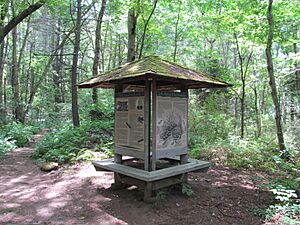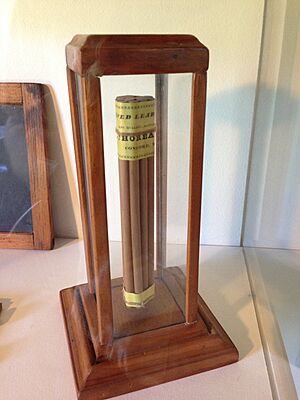Nashoba Brook Pencil Factory Site facts for kids
The Nashoba Brook Pencil Factory Site holds the old remains of a pencil factory from the 1800s. This factory used power from a dam. It was one of many factories in Acton and Concord, Massachusetts that helped make pencils better. Today, you can still see parts of its dam and some old machine pieces. The site is in the Nashoba Brook Conservation Area in Acton, Massachusetts. It's right by Nashoba Brook and the old Davis Road Dam. You can visit the site by following a marked path from the Davis Road parking area.
Contents
How Pencils Were Made in the 1800s
The first American pencil factories started in Concord in the 1800s. In 1812, William Munroe, a cabinet maker from Concord, was the first American to successfully make and sell pencils with wood around them.
Later, the Thoreau family pencil business became Munroe's main competitor. This business was run by John Thoreau, who was the father of the famous writer Henry David Thoreau. In 1821, John Thoreau's brother-in-law, Charles Dunbar, found a lot of graphite in Bristol, New Hampshire. Graphite is the material used for the "lead" in pencils. In 1823, Dunbar asked John Thoreau to join him in making pencils from this graphite. Dunbar later left the company, and it became known as John Thoreau & Company. Henry David Thoreau worked at his family's factory for most of his adult life.
Ebenezer Wood: An Inventor of Pencils
The person who started the factory at this site was Ebenezer Wood (1792–1880). Wood made some important improvements to how pencils were made. For example, he started using a circular saw to cut the wood for pencils. He also created pencils with eight or six sides. The six-sided shape is now very common for pencils.
Ebenezer Wood was also a cabinet maker, just like William Munroe. This might be why Munroe hired Wood to help him cut the wood casings for his pencils. Wood later brought more machines and automation into Munroe's factory.
After that, Wood started his own mill to grind plumbago, which is another name for graphite. At first, Munroe bought graphite from him. But by the 1830s, Wood sold his graphite only to the Thoreau company. This business relationship lasted for many years. People say that Henry David Thoreau bought his sketching pencils from Wood's factory.
Factories Along Nashoba Brook
This pencil factory was one of several mills that used power from Nashoba Brook. The factory was located on the west side of the stream, closer to the Framingham & Lowell Railroad tracks. You can't reach the site directly from the Pencil Factory Kiosk or the Nashoba Brook Conservation Area trails right now. However, the kiosk does have a picture of the site from around 1900. You can see the site from the new part of the Bruce Freeman Rail Trail. There's also a historical sign and a photo along the trail that explain how important the site was and what Ebenezer Wood did.
Upstream, on the north side of the Nashoba Brook Conservation Area, is the Robbins Mill Pond Dam. The town fixed this dam in 1990. Paths run along both sides of Nashoba Brook, connecting the upstream sites to the Pencil Mill.
Another pencil factory was located downstream at Brook Street.
The Trail Through Time Project
The Pencil Factory is planned to be part of Acton's Trail Through Time. This trail is being created to show how North Acton's Nashoba Brook area was settled and used over time. Besides the Factory site, other interesting places on the trail will include the Potato Cave and the Wheeler Farm site.
Important Dates
| 1792 | Ebenezer Wood was born |
| 1812 | William Munroe started making pencils |
| 1817 | Henry David Thoreau was born |
| 1821 | Charles Dunbar found graphite in New Hampshire |
| 1823 | John Thoreau started working with Dunbar |
| 1830s | Wood's mill started grinding graphite only for the Thoreau family |
| 1837 | Henry David Thoreau returned to Concord from Harvard University |
| 1862 | Henry David Thoreau passed away |
| 1880 | Ebenezer Wood passed away |
| 1987 | Nashoba Brook Conservation Area opened |
| 1990 | Robbins Mill Pond Dam was fixed up |
| 1999 | Jeff LeBlanc built the site kiosk for his Eagle Scout project |
See also



